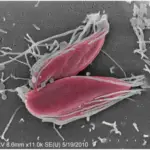Leishmaniasis Infection is a parasitic disease caused by infection with Leishmania parasites, which are spread by the bite of phlebotomine sand flies.
What is the Pathology of Leishmaniasis Infection?
The pathology of leishmaniasis infection is:
-Etiology: The cause of leishmaniasis infection is Leishmania parasites.
-Genes involved: Not applicable.
-Pathogenesis: The sequence of events that lead to leishmaniasis infection are: After inoculation by sandflies, the flagellated promastigotes bind to macrophages in the skin, activate complement system, the parasitized macrophages disseminate infection to all parts of the body but more so to the spleen, liver, and bone marrow.
-Morphology: The morphology associated with leishmaniasis infection shows a structure similar to a volcano, with a raised edge and central crater. Some sores are covered by a scab.
-Histology: The histology associated with leishmaniasis infection shows dermal granulomatous inflammation with predominant lymphocytes, histiocytes contain small oval organisms with bar shaped paranuclear kinetoplast.
How does Leishmaniasis Infection Present?
Patients with leishmaniasis infection typically are all genders of all ages. The symptoms, features, and clinical findings associated with leishmaniasis infection include decreased production of blood cells, bleeding, enlarged spleen, enlarged liver, weight loss, and fever.
How is Leishmaniasis Infection Diagnosed?
Leishmaniasis infection is diagnosed by tissue specimens from skin lesions, and bone marrow.
How is Leishmaniasis Infection Treated?
Leishmaniasis infection is treated by medications intravenous liposomal amphotericin B.
What is the Prognosis of Leishmaniasis Infection?
The prognosis of leishmaniasis infection is fair. It spontaneously resolves in 3-6 months without therapy, although some infections persist indefinitely.



